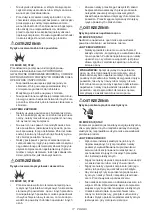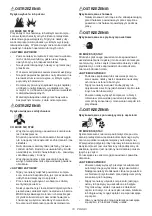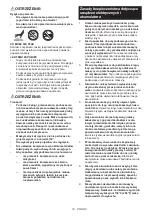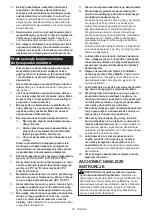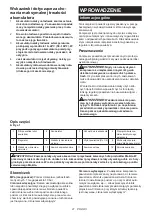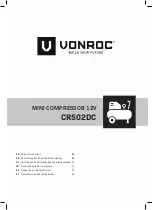
6 ENGLISH
WARNING:
Risk to Breathing
WHAT CAN HAPPEN
•
The compressed air from your compressor is not
safe for breathing.
The air stream may contain carbon monoxide or
other vapors, or particles from the tank or other
components.
•
Sprayed materials such as paint, paint solvents,
paint remover, insecticides, weed killers, etc.,
contain harmful vapors and poisons.
•
Breathing compressor or sprayed materials vapor
can result in serious injury.
HOW TO PREVENT IT
•
Never inhale air from the compressor, either
directly or from a breathing device connected to
the compressor.
•
Work in an area equipped with good cross
ventilation.
•
Read and follow the safety instructions provided
on the label or safety data sheet for the material
you are spraying.
Use an approved respirator designed for use with
your specific application.
•
Do not carry the compressor while painting.
WARNING:
Risk from Noise
•
Wear hearing protection to protect your ears
against exhaust noise and noise during operation.
WARNING:
Risk from Compressed Air
WHAT CAN HAPPEN
The compressed air stream can cause soft tissue
damage, and can propel dirt, chips, loose particles and
small objects at high speed, resulting in property dam
-
age or personal injury.
HOW TO PREVENT IT
•
Always wear approved safety glasses with side
shields when using or maintaining the compressor.
•
Never point any nozzle or sprayer toward any part
of the body or at other people or animals.
•
Always turn the compressor off and bleed pres
-
sure from the air line before attempting mainte-
nance, attaching tools or accessories.
WARNING:
Risk from Moving Parts
WHAT CAN HAPPEN
The compressor cycles automatically when the On/
Auto-Off switch is in the On/Auto position. If you attempt
repair or maintenance while the compressor is operating
or plugged in, you can expose yourself to moving parts.
These moving parts can cause serious injury.
HOW TO PREVENT IT
•
Always turn off the On/Auto-Off switch and remove
the battery cartridge. After that, release air pres-
sure from the tank and any attachments before
attempting any maintenance or repair.
•
Never operate the compressor with guards or
covers which are damaged or removed.
•
Keep your hair, clothing, and gloves away from
moving parts. Loose clothes, jewelry, or long hair
can be caught in moving parts.
•
Air vents may cover moving parts and should be
avoided as well.
WARNING:
Risk of Burn
•
Do not operate the portable compressor with
the doors or enclosures open!
•
Do not open the cock before the air hose is
attached!
WHAT CAN HAPPEN
Contact with hot parts such as the compressor head or
outlet tubes could result in a serious skin burn.
HOW TO PREVENT IT
•
Never touch hot components during or immedi-
ately after operation of the compressor. Do not
reach around protective shrouds or attempt main-
tenance until the compressor has been allowed to
cool.
•
Always hold the handle when move or transport
the compressor.
•
During using the compressor and within one hour
after use, do not touch the heated parts such as
cylinder, cylinder head, and exhaust hose. These
parts become hot and can cause burn injury.
WARNING:
Transport
•
Always hold the handle when handling, lifting,
moving, or transporting the compressor. Do
not attempt to pull or carry the air compressor
by the hose. Doing so may damage the com-
pressor and/or hose.
•
Always carry the compressor in the correct
way. Transporting and lifting in wrong way may
cause the compressor damaged.

















